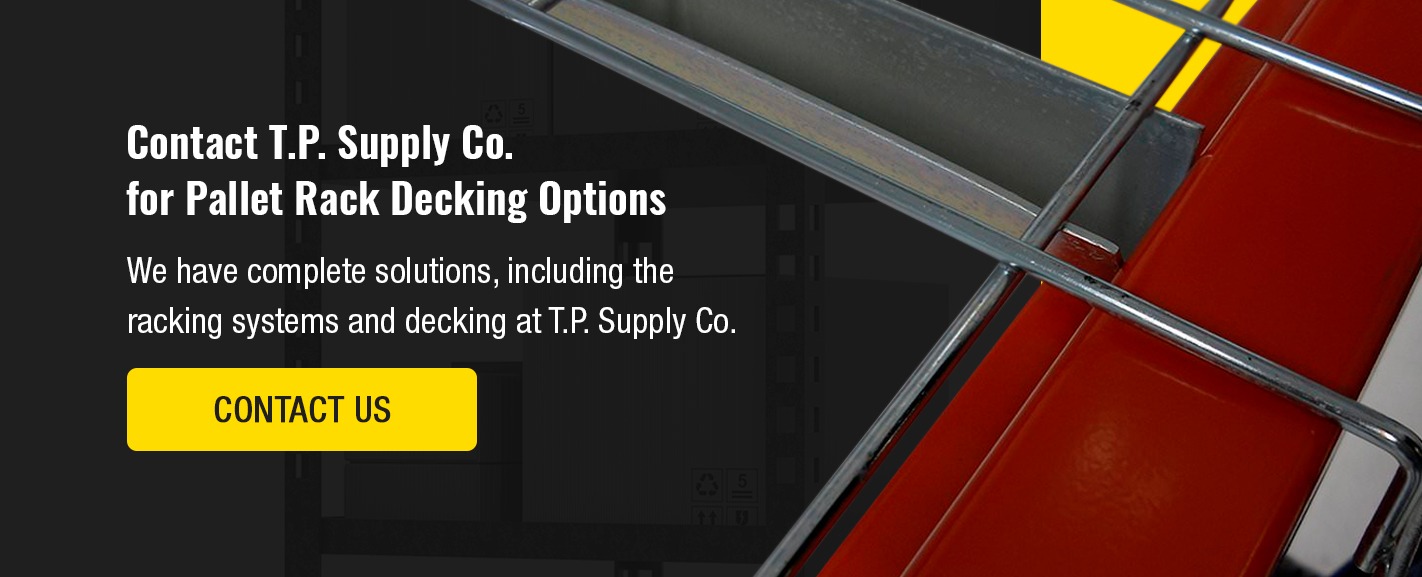Benefits of Wire Decking for Pallet Racks
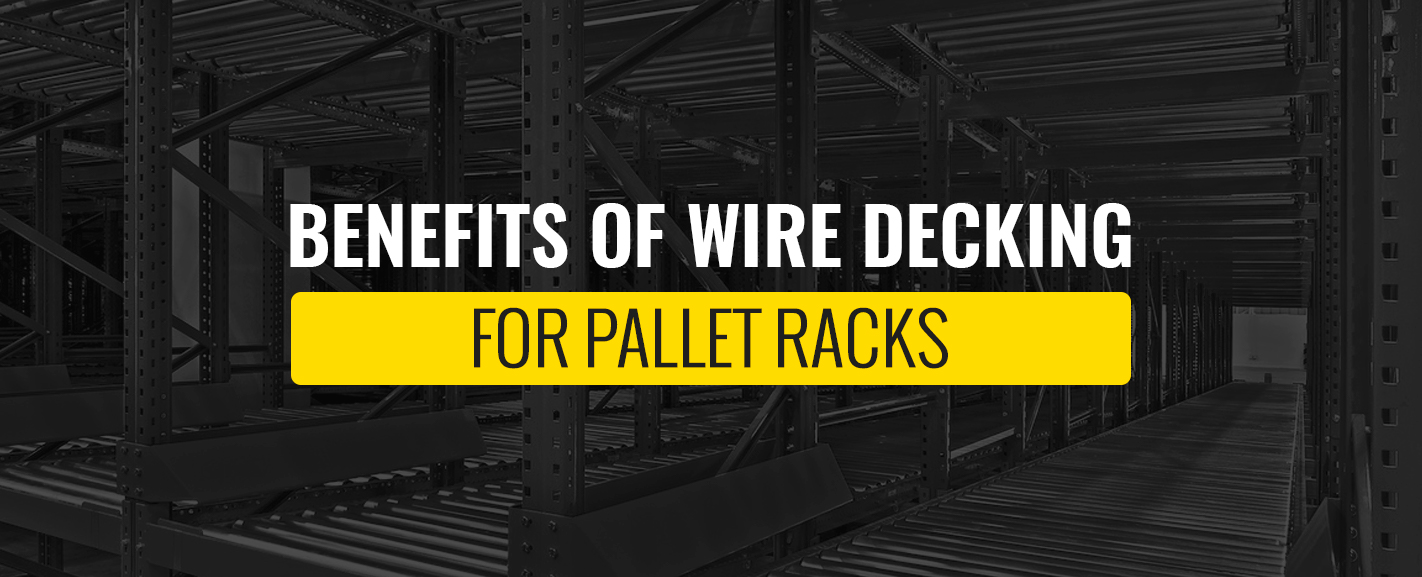
Adding wire mesh decking to pallet racks increases the uses of the racking system. Wire decking provides a stronger, longer-lasting alternative to wood boards between beams. The mesh design also improves airflow, critical for storing temperature and moisture-sensitive products. See how pallet rack wire decking can transform a storage area for the better.
What Is Wire Decking for Pallet Racks?
Mesh wire decking has an open-weave design of durable metal. Depending on the model, the pieces of decking fit in between or over the pallet rack’s support beams. The decking does not and should not support the full weight of the pallets, but it does help distribute weight across the support beams, making storage safer.
Wire decks help catch anything that falls from the pallets, preventing lost products or spills from falling to the floor. Without the mesh decking in place, products could get lost if they fall from a pallet onto a pallet below or to the floor.
1. Uses for Pallet Rack Wire Decking
Several industries use wire mesh decking for their operations, including food, retail and warehousing. However, any sector that uses pallet racks can also add to their usefulness with wire decking. The decking offers better support and light and air filtering between the beams.
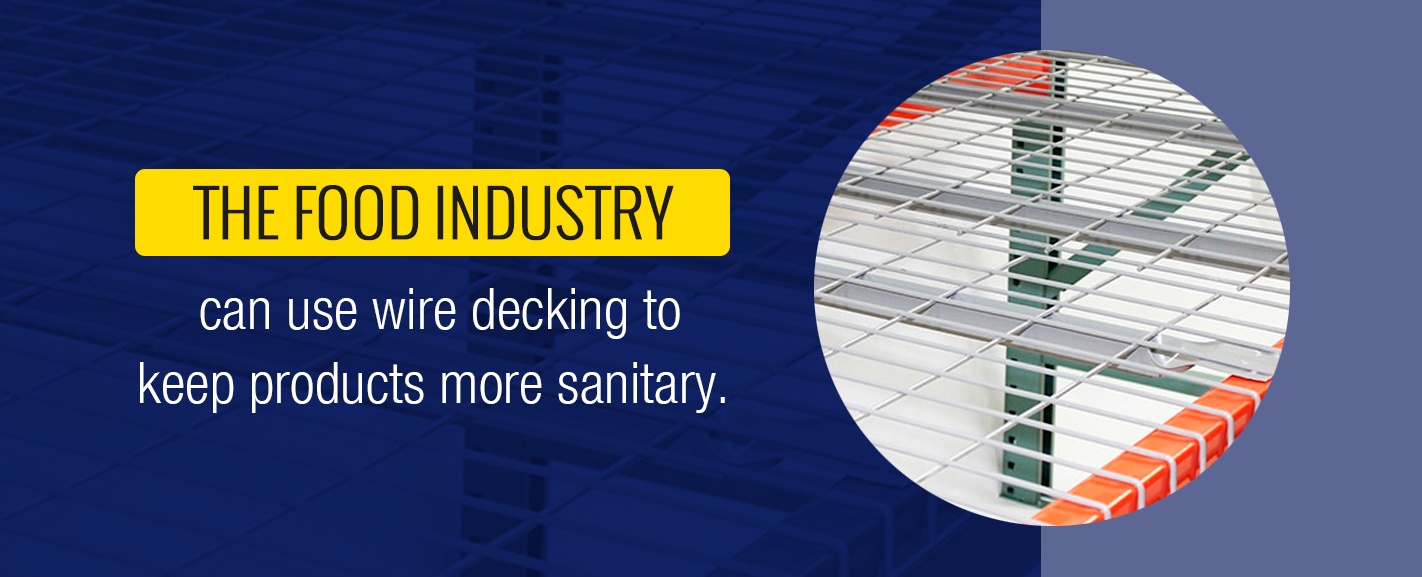
The food industry can use wire decking to keep products more sanitary. The woven design allows for plenty of airflow, while preventing bacteria growth from spills. The surfaces also do not accumulate dust or enable pests to easily crawl to the food inside the palletized containers.
While most retail facilities don’t resemble warehouses, outlet stores and similar places may have pallet racks where customers shop. One store that has implemented pallet racks on the selling floor is furniture giant Ikea. The store’s addition of wire decking to its pallet racks was part of a two-part plan to reduce the use of wood pallets. They opted to replace wooden pallets with corrugated models. These lighter pallets required extra support on the pallet racks in the form of wire decking.
The wire decking can support the corrugated pallets only because they weigh much less than wood, and the pallets require the added support from the decking. This mutually beneficial arrangement reduces the use of wood and ensures the safe support of the store’s pallets.
Warehouses and manufacturing can also use mesh decking for added safety in their facilities. The decking adds more support under the pallets while reducing the risk of fires spreading because the decks have a nonflammable construction.
2. Safety Tips for Wire Decking
Wire mesh decking offers many benefits, but only if used safely. Weight capacity and type of decking play critical roles in how much support these metal parts give to the pallets above them. Without regard to these safety measures, severe damage to people and products could occur.
When using wire decking, the type of mesh used must match the load it needs to support. Don’t use wire decking to indiscriminately hold up any loaded pallet. Match the wire mesh decking load to the pallet, and do not allow the decking to be the only means of support for the pallet unless it is lightweight or empty. Place pallets so they create a uniformly distributed load, which happens when products on pallets cover the decking to all edges — front to back and side to side. Rack beams made to hold 5,000 pounds should use a pair of 2,500-pound-capacity decks to properly carry the required load.
Never allow anyone in the facility to stand or walk on wire decking. Regardless of the deck’s capacity, it has a design for static loads, not the dynamic pressure put on it by a person. The Rack Manufacturers Institute warns decking could cause people to trip. It could also tip over or slip out if a person stands on it or someone puts uneven pressure by improperly stacking pallets on it.
Another aspect to safely using wire decking is choosing the correct type for the load and application in addition to looking at the weight capacity. Pallet rack decking options exist to match the type of beams used in the racking system. While universal solutions exist, they may not serve a specific purpose needed in a facility.
Different Types of Wire Decking
Wire mesh decking has several variations. The most generalized differences come in whether the decking rests over the edges of the beams or inside the beam steps — drop-in or waterfall. Forms for the support channels in the decking also differ — flared or step. Combinations of these create the many wire decking options available. Some decking styles may even have inverted options for more variation. Pallet rack decking options include:
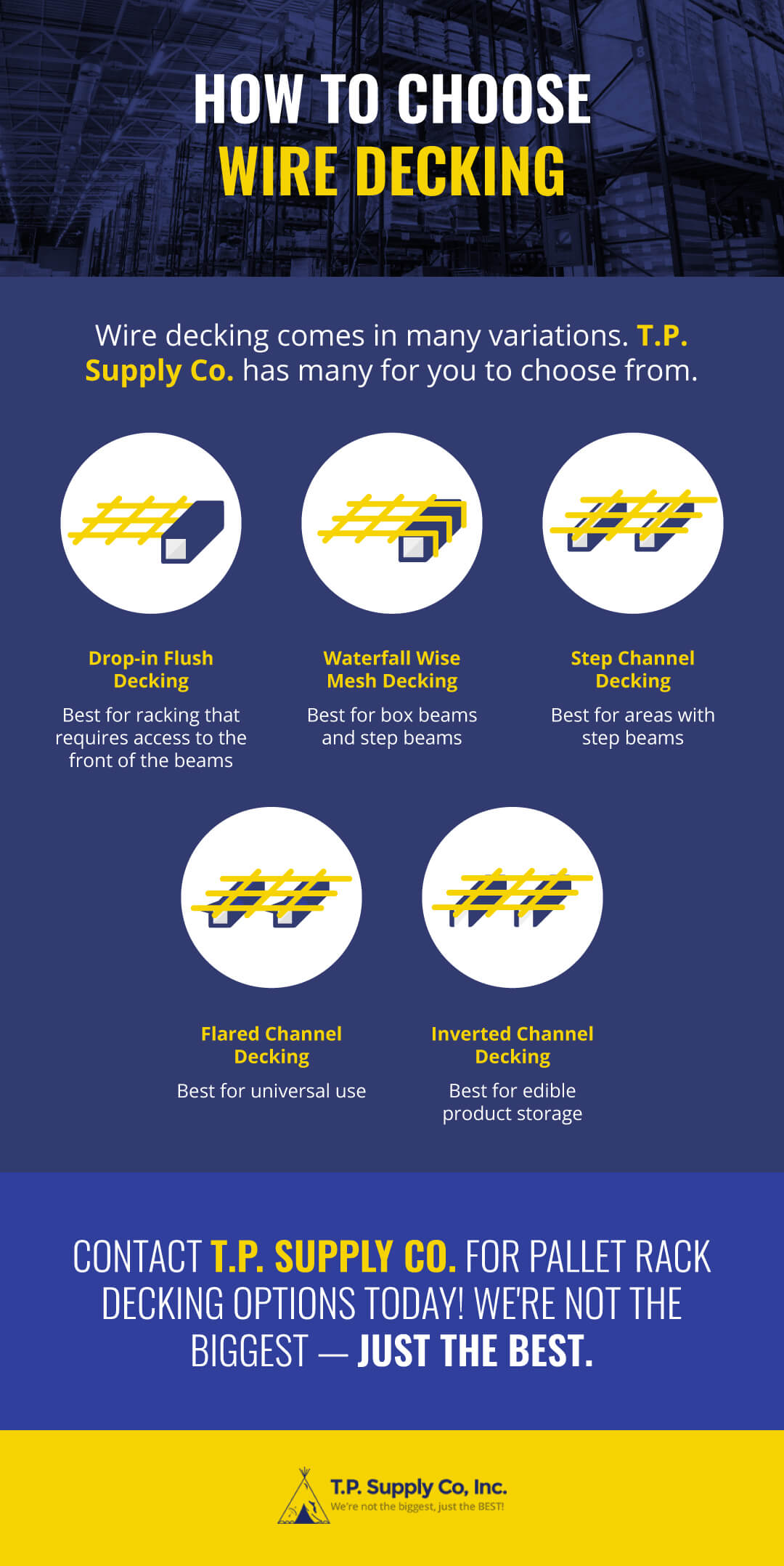
1. Drop-In Flush Decking
As the name suggests, flush decking aligns with the surface of the beams. It drops into place and has support from the base of step beams.
The best use for drop-in flush decking is on racking that requires access to the front of the beams. If workers affix barcodes to the beams for scanning when pulling products, flush decking does not have wires that block the barcode, allowing for clean scanning.
Another benefit of flush decking is the lack of edges on which a worker can cut a hand or snag equipment. Flush decking works best for facilities where workers must handpick products. The decking offers the added safety of keeping the metal parts inside the step beams.
The drop-in nature of this type of decking means it fits neatly between the top parts of step beams on the racking system without needing any tools for installation.
2. Waterfall Wire Mesh Decking
Waterfall wire mesh decking gets its name from the overhanging form created by the mesh over the edge of the support beams. This type of decking sits on top of the beams, and both box beams and step beams can accommodate it.
A variation of the waterfall decking is an inside waterfall. This design has the lip on the edge of the deck, but its side sits on top of the base of a step beam. Another type of waterfall deck is an inverted form, which has the lip directed upward for keeping rolling goods on the shelves.
Waterfall mesh decking is a popular option due to its ability to fit over different types of beams. If covering the front of the rack with the edge of the waterfall deck will not cause a problem, this decking option will suffice.
3. Step Channel Decking
Aside from whether the decking fits over or into the beams, the other options come from the type of channels. Step channel decking has a U-shaped support channel for the deck that has its ends resting on the bottom portion of a step beam at either end.
Both waterfall and drop-in decks may use this channel design. As long as the rack uses step beams, this form of the deck will work.
4. Flared Channel Decking
With flared decking, the ends of the support channels flare out. This design allows the decking to work universally with either box or step beams, but it is not compliant with all types of decking.
The flare sits under a waterfall lip, which ensures the channel ends stay in place. Since the flared end rests on top of the beams in the front and back, this design does not work with drop-in decking.
5. Inverted Channel Decking
Inverted channel design comes in both standard and flared forms. These have channels with an inverted U-shape. The upside-down structure prevents the accumulation of dust, food particles and debris. In facilities that store edible products, such design ensures regulatory compliance.
Because this type of decking is an option for step and flared channels, it has universal application, depending on the other options. For step beams, pair this with either drop-in and step channels. For box beams, select waterfall and flared channels.
Advantages of Wire Decking Over Wood and Other Substitutes
When selecting decking for racks, don’t use wooden boards or other substitutes. These alternatives are wasteful, cost more money, take more time to install and increase the risk of pathogens and fire spread. Don’t risk the safety of workers and the security of pallet contents by using the incorrect decking material.
1. Wear Resistant
Wire mesh decking has a durable, long-lasting construction. Compared to wood that can warp and splinter, wire decking does not experience these forms of wear. Selecting galvanized decking reduces the chances of forklifts or pallets, causing damage to the decking.
Since wire decking for pallet racks does not wear as quickly as wooden planks do, it offers a longer-lasting investment in supporting pallets and their loads. Paying for decking is an investment in proper warehouse equipment that will last for years, even with heavy usage.
2. No Cutting
Whereas wood requires cutting to size and can only fit between step beams, wire decking does not need cutting. Each decking fits standardized rack sizes to ensure a proper fit. Additionally, wood does not have a means of holding onto the beams as waterfall decking does. If not cut correctly, wood has a chance of falling through the racks or not fitting well.
Why waste time cutting to try to achieve the proper fit when wire decking already comes produced in the perfect size to fit between step beams or over box beams?
3. Easy to Install
Because wire decking comes in premade sizes, it fits perfectly onto the racks without tools. The lips on waterfall decking hold the deck in place and prevent the beams from moving apart. Drop-in decking fits perfectly into place, as well, but it needs some additions during installation to improve its security.
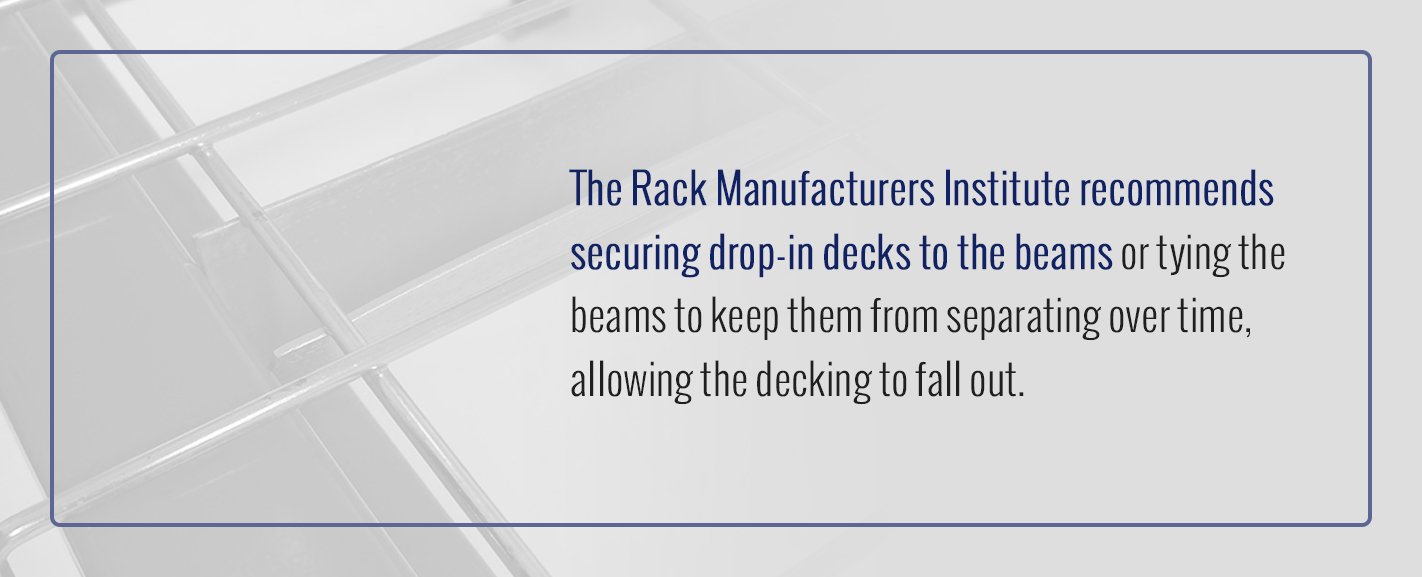
Drop-in decks slip into place. However, placing them between step beams should not be the only step. The Rack Manufacturers Institute recommends securing drop-in decks to the beams or tying the beams to keep them from separating over time, allowing the decking to fall out.
4. Safer
Wire decks are much safer than wooden alternatives in several ways — preventing contamination of products, reducing fire spread and better securing of the racked goods.
Wooden planks between racks create a solid surface. Without gaps to allow for spilled products and dust to flow down to the floor, the products have an increased risk of contamination from dirt, bacteria or pests. The solid surfaces make it easier for rats and bugs to crawl across the wooden planks to the pallets and the products on them. In food-storage situations, this could cause significant product loss from contamination.
Next, in the event of a fire, flammable wood planks hasten the spread of the flames. Additionally, solid planks block the flow of water from fire sprinklers, reducing the efficiency of the facility’s fire suppression system.
Lastly, wire mesh decking secures to the racks better than wooden planks. If wooden planks sit on top of the beams, they can slip when moving the pallets on top, causing the loss of the load. Even when placed between step beams, wood boards can still fall through if the racks pull apart even a small amount.
5. Lower Cost
The cost of cutting, installing and replacing wood boards over time will cost much more for a rack system than a wire decking designed to fit the rack. Once installed, wire decking will require little to no maintenance. The longevity reduces the amount paid for the deck over the lifetime of the pallet racks it fits onto.
Comparing prices between wooden boards and wire decking for racks, buyers find the costs are similar. When considering the amount of time required to make wood boards fit and to replace them regularly, wire decks cost much less.
6. Stronger
Compared to wood, wire decking is stronger. Mesh decking has a variety of weight capacities, but most start at 2,500 pounds when loads have a uniform distribution. The weight supported by the decking should never exceed the amount the racks can hold. Wood cannot support such heavy loads. Furthermore, wood may weaken if it gets wet or as it ages, reducing the total amount it can carry over time.
7. Better Lighting
While solid wood boards block out light from above, mesh decking lets light through. Workers under the decks still get enough light to see clearly. By preserving the illumination in the area, wire decks can keep workers safer by helping them to avoid trip hazards.
Contact T.P. Supply Co. for Pallet Rack Decking Options
If you have pallet racks, upgrade them with the right wire mesh decking. We have complete solutions, including the racking systems and decking at T.P. Supply Co. If you would like to get started on finding the right decking and pallet racks for your facility, contact us through our online quote tool. We will work with you to get a customized quote.
Do you have a tight budget? Don’t worry. We have three pricing levels of equipment to help you find the wire mesh decking and more in new, used and reconditioned states to match your facility needs and budgetary concerns. Let us become your partners in improving your facility’s ability to safely and effectively store everything you need.


